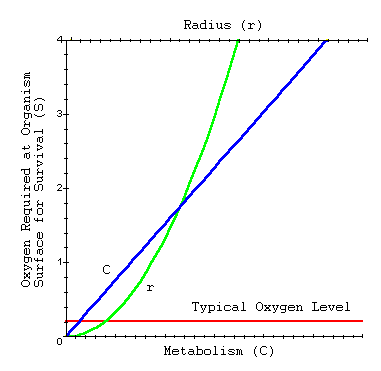
OXYGEN DIFFUSION IN SIMPLE ORGANISMS
Introduction: Many simple organisms do not have specialized respiratory structures and instead obtain oxygen by diffusion through their body surfaces.
Importance: We can use a simple equation to assess properties of an organism that can survive by diffusion alone.
Question: How is the oxygen need of an organism related to its metabolism and size?
Variable:
|
S |
concentration of O2 required at surface of organism for survival (atm) |
|
C |
rate of oxygen consumption ((cm3 O2/cm3 tissue)/min) |
|
r |
radius of spherical organism (cm) |
|
K |
diffusion constant ((cm2/atm)/min) |
Methods: E. Newton Harvey (1928) developed the following equation to describe the concentration of oxygen required to supply a spherical organism with oxygen by diffusion:

where S is the required concentration of oxygen at the surface of an organism, C is the rate of oxygen consumption (cm^3 of oxygen/cm^3 tissue/min), r is the radius of the organism (cm), and K is the diffusion constant (cm^2/atm/min).
We can plot S as a linear function of C and as a parabolic function of r. A diffusion constant of 11x10^-6 cm^2/atm/min is typical for many animal tissues

Interpretation: We can see that as organism metabolism (oxygen consumption) or organism size increases, a greater amount of oxygen is needed at the surface of the organism for survival. Well areated water typically contains 0.21 atm oxygen. We can compare the intercept S = 0.21 with the graphs of C and r. Even well-aerated water is well below the required oxygen level for organisms of large size or high metabolism.
Conclusions: By trying hypothetical organisms in the equation, one sees that for an organism to survive by diffusion alone, it must either be very small or have a very low metabolic rate. Larger organisms or those with high metabolic rates must develop respiratory structures in order to meet their oxygen needs.
Additional Question:
1. How does the slope of S as a linear function of C change with increasing radius? What does this imply about an organism?
Source: Schmidt-Nielsen, K. 1990. Animal Physiology: Adaptation and environment, Cambridge University Press, Cambridge
Harvey, E. N. 1928. The oxygen consumption of luminous bacteria. J. Gen. Physiol. 11:469-475.
Copyright 1999 M. Beals, L. Gross, S. Harrell